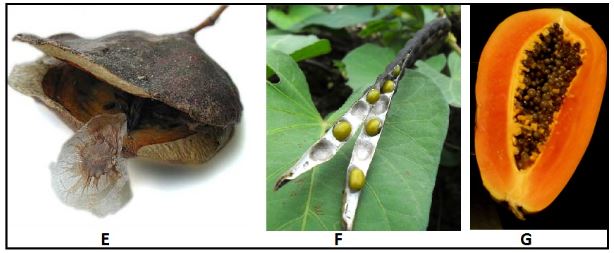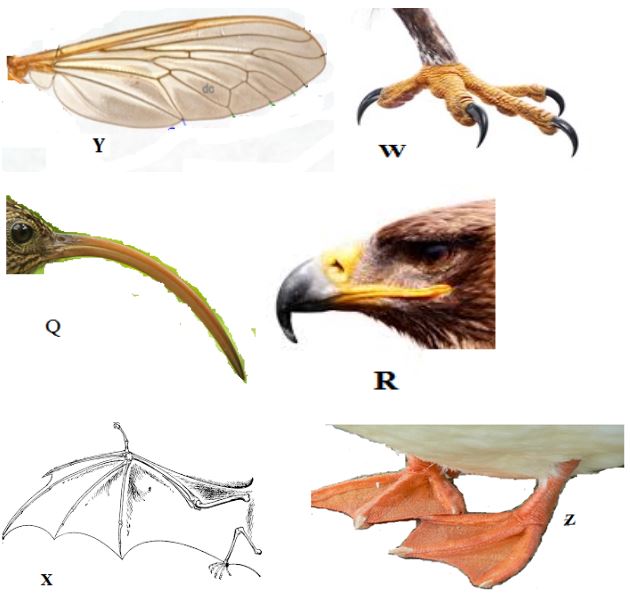INSTRUCTIONS TO CANDIDATES
- Answer all the questions
- You are required to spend the first 15 minutes of 1¾ hours allowed for this paper reading the whole paper carefully before commencing your work.
- Candidates may be penalized for recording irrelevant information and for incorrect spelling especially of technical terms.
- You are provided with a fruit labeled K. You are required to cut transversely through the middle section of the fruit using the knife provided.
- Cut a 1cm slice from one half of the fruit and remove the peel. Place the soft part of the fruit in a mortar and mash it into a fine paste using a pestle. Add 10ml of distilled water into the paste and stir the mixture, then transfer it into a beaker.
- Using the reagents provided, carry out appropriate food tests on the mixture as you fill in the table below. (11 marks)
Food substance Procedure Observation Conclusion - Name the deficiency disease in children that may result from feeding them on specimen K alone especially after weaning. (1 mark)
- Identify the hormone responsible for ripening of the specimen K above. (1 mark)
- The photographs below show various types of fruits.
-
- State the mode of dispersal of the fruit in photograph E. (1mark)
- Give a reason for your answer. (1mark)
-
- What type of fruit is shown in photograph F? (1mark)
- Give a reason for your answer. (1mark)
- Explain how this fruit is suited to its mode of dispersal .(2 marks)
-
- Name the type of fruit in photograph G. (1mark)
- Give two reasons for your answer. (2 marks)
- Name the type of placentation in this fruit. (1mark)
- State two ways in which the fruit is adapted to its mode of dispersal. (2 marks)
-
- Study the photographs below and answer the questions that follow.
- Name the type of structures shown by: [2marks]
- X & Y
- W & Z
- State the structural difference between structures X and Y [2 marks]
- Name the type of evolution shown by structures Q and R [1 mark]
- State the adaptations of structures W and Z (2 marks)
- Name the types of skeletons shown by structures X and Y [2mks]
- By comparing structures Q and R, predict the type of food being fed on by the animals and give a reason in each case. [4 marks]
Q
R - A part from structures X and Y, name two other examples of similar structures in animals. [2 marks]
- Name the type of structures shown by: [2marks]
CONFIDENTIAL
The information contained in this paper is to enable the Head of the school and the teacher in charge of Biology to make adequate preparations for the Biology practical examination.NO ONE ELSE should have access to this paper or acquire knowledge of its contents. Great care MUST be taken to ensure that the information herein does not reach the candidate either directly or indirectly. The teacher in charge of Biology should NOT perform any of the experiments or give any information related to these instructions to the candidates.
Each student will require:
- Ripe banana (Fruit labelled K)
- Benedict’s solution supplied with a dropper
- Sodium hydroxide solution supplied with a dropper
- Copper (II) sulphate solution supplied with a dropper
- Iodine solution supplied with a dropper
- Three test tubes
- Test tube holder
- Labels
- Means of heating
- Knife/Scalpels
- Beaker
- Distilled water in a wash bottle
- Mortar and pestle
- A ruler
- The photographs SHOULD BE COLOURED
MARKING SCHEME
- You are provided with a fruit labeled K. You are required to cut transversely through the middle section of the fruit using the knife provided.
- Cut a 1cm slice from one half of the fruit and remove the peel. Place the soft part of the fruit in a mortar and mash it into a fine paste using a pestle. Add 10ml of distilled water into the paste and stir the mixture, then transfer it into a beaker
- Using the reagents provided, carry out appropriate food tests on the mixture as you fill in the table below. (11 marks)
Food substance Procedure Observation Conclusion Starch
√ (½)To 2ml test material in test tube; add 3 drops of iodine solution, shake
√ (1)Blue-black colour
√ (1)Starch present
√ (1)Reducing sugar
√ (½)To 2ml of test material in test tube; add equal amounts of Benedicts √ (1) solution; heat √ (1) in water bath; Green / yellow / orange / brown colour. √ (1) Reducing sugar present;
√ (½)Proteins
√ (½)To 2ml of test material; add equal amounts of NaOH √ (1); add CuSO4 √ (1) dropwise; shaking after each drop. Blue colour persists
√ (½)Proteins absent
√ (½) - Name the deficiency disease in children that may result from feeding them on specimen K alone especially after weaning.
- Kwashiorkor √ (1) (
- Identify the hormone responsible for ripening of the specimen K above.
- Ethylene / ethane √ (1)
-
-
- Censor mechanism;
Wind- Accept self dispersal;
-
- Presence of a suture / lines of weakness / an opening at the tip;
- Has wing-like membranous structure /membranous extension.
- Censor mechanism;
-
- Legume;
- Has two lines of weaknesses / sutures;
- Has (two) sutures along which it splits to release the seeds;
-
- Berry;
-
- Have fleshy pericarp;
- Has many seeds
- Parietal;
-
- Brightly coloured pericarp to attract animals for dispersal;
- Fleshy pericarp to attract animals for dispersal;
-
- Study the photographs below and answer the questions that follow.
- Name the type of structures shown by: [2mks]
- X & Y - Analogous
- W & Z - Homologous
- State the structural difference between structures X and Y [1mk]
- X - Pentadactyl limb structure
- Y - Toughened veins with cuticles
- Name the type of evolution shown by structures Q and R [1mk]
- Divergent evolution
- State the adaptations of structures W and Z
- W - sharp and curved claws/tattoos to grasp and hold prey
- Z - webbed feet to wade/swim in water
- Name the types of skeletons shown by structures X and Y [2mks]
- X - Endoskeleton
- Y - Exoskeleton
- By comparing structures Q and R, predict the type of food being fed on by the animals and give a reason in each case. [4mks]
- Q Nector – long and slender break to reach nectarines / nector
- R Flesh/meat – strong curved for tearing flesh
- A part from structures X and Y, name two other examples of similar structures in animals. [2mks]
- Eyes of man and octopus
- Flipperss in whales and fins in fish
- Name the type of structures shown by: [2mks]
Download Biology Paper 3 Questions and Answers with Confidential - Samia Joint Mock Examination 2023.
Tap Here to Download for 50/-
Get on WhatsApp for 50/-
Why download?
- ✔ To read offline at any time.
- ✔ To Print at your convenience
- ✔ Share Easily with Friends / Students


